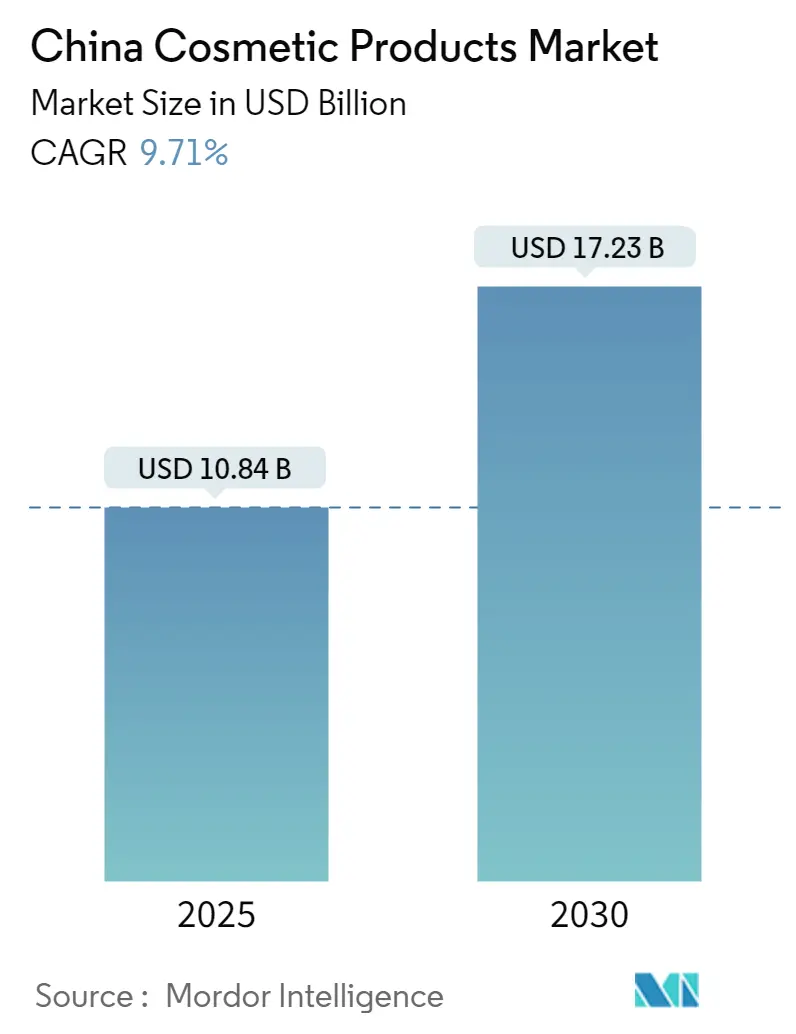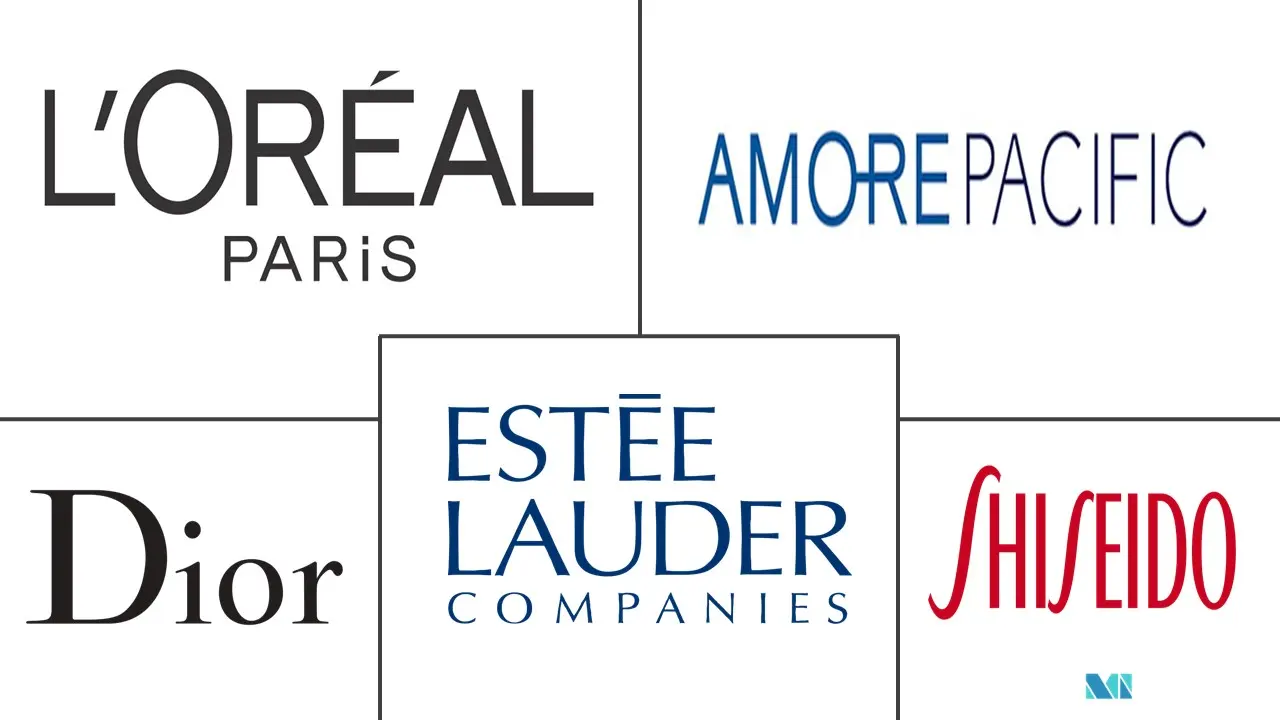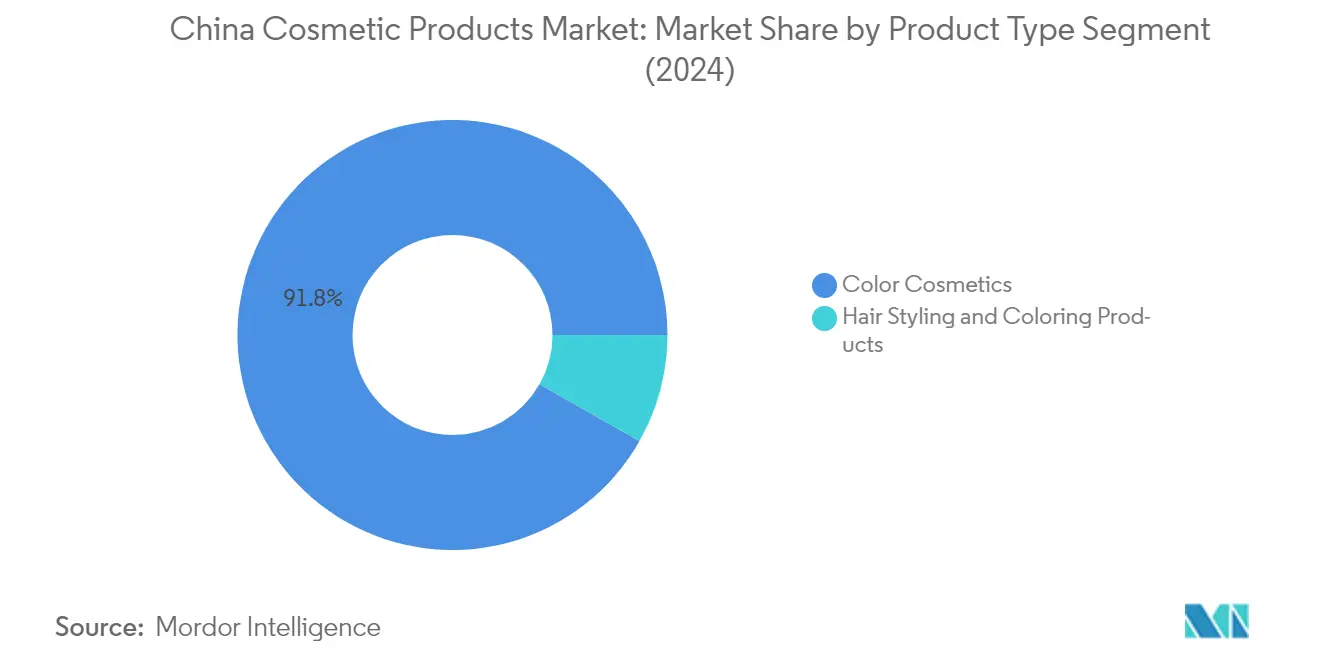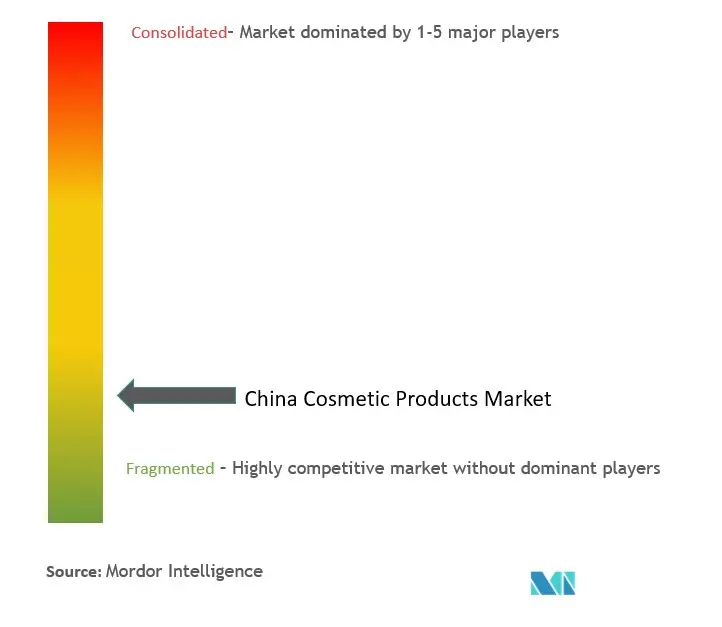
| Study Period | 2019 - 2030 |
| Base Year For Estimation | 2024 |
| Forecast Data Period | 2025 - 2030 |
| Market Size (2025) | USD 10.84 Billion |
| Market Size (2030) | USD 17.23 Billion |
| CAGR (2025 - 2030) | 9.71 % |
| Market Concentration | Low |
Major Players
*Disclaimer: Major Players sorted in no particular order |
China Cosmetics Products Market Analysis
The China Cosmetic Products Market size is estimated at USD 10.84 billion in 2025, and is expected to reach USD 17.23 billion by 2030, at a CAGR of 9.71% during the forecast period (2025-2030).
The Chinese cosmetics industry is experiencing a significant transformation driven by changing consumer behaviors and digital innovation. Social media has created more sophisticated beauty consumers at a younger age, with these consumers having higher disposable incomes and starting with luxury beauty products rather than traditional entry-level products. According to industry data, Chinese netizens spend an average of 8 hours per week on social networks, significantly influencing their beauty products purchasing decisions. The digital landscape has become particularly crucial for brand success, with e-commerce and social media serving as powerful engines for cosmetics sales and consumer engagement.
The market is witnessing a notable shift towards premium cosmetics and functional cosmetics products, driven by increasing consumer sophistication and rising disposable incomes. Consumers are increasingly seeking products that offer multiple benefits beyond basic functionality, particularly those containing natural and botanical ingredients. This trend is exemplified by the establishment of China's first commercialization platform for functional cosmetics by Qingdao Baheal Medical Inc., which aims to facilitate brand entry through medical standards, consumer experience improvement, and precision marketing programs.
Live streaming has emerged as a crucial marketing channel in China's cosmetics industry, with brands integrating it into their strategies to engage large masses of users effectively. Key Opinion Leaders (KOLs) have become instrumental in shaping consumer preferences, with successful influencers like "Brother Lipstick" amassing over 31 million followers on Douyin and generating significant product sales through their recommendations. The transparency and authenticity offered by these marketing channels have become particularly important for Chinese consumers who rely heavily on demonstrative content before making purchase decisions.
The market is characterized by innovative distribution strategies and omnichannel presence. Major retailers are adopting integrated approaches to reach Chinese consumers, exemplified by Sephora's strategy of combining various platforms including T-Mall, JD.com, WeChat, and its website Sephora.cn. The retail landscape continues to evolve with the emergence of new specialty stores focused on cost-effective, high-quality Chinese brands. For instance, retail chains like Wow Colour have introduced stores offering 130 brands, many of which were previously online-only brands, demonstrating the market's dynamic nature in bridging the online-offline retail divide.
China Cosmetics Products Market Trends
Heavy Marketing Strategies by Manufacturers
The Chinese cosmetics market is being significantly shaped by innovative marketing strategies, particularly through digital channels and key opinion leaders (KOLs). Live streaming has emerged as a crucial marketing tool, with platforms integrating this feature to showcase product authenticity and personalization in real-time. This marketing approach has proven highly effective, now accounting for approximately 10% of Chinese e-commerce transactions, demonstrating its integral role in successful multi-channel sales strategies. The transparency and authenticity offered through live streaming particularly resonate with Chinese consumers who value genuine product demonstrations and immediate feedback.
The influence of KOLs in the cosmetics sector has reached unprecedented levels, with figures like Austin Li, known as "Brother Lipstick," amassing over 31 million followers on Douyin and generating 100 million likes. These influencers produce educational content through watch-and-learn videos, sharing essential beauty tips and techniques that directly influence consumer purchasing decisions. Major brands have recognized this trend, with companies like Sephora integrating various platforms and marketing strategies to engage with their customer base across multiple channels, including T-Mall, JD.com, WeChat, and their dedicated websites. This multi-platform approach ensures comprehensive market coverage and enhanced consumer engagement.
Growing Demand for Natural and Clean Label Products
Chinese consumers are increasingly gravitating towards natural cosmetics products, driven by a growing awareness of ingredient safety and environmental sustainability. This shift is characterized by a strong preference for products containing herbal beauty ingredients, which are perceived to offer superior health and skin benefits. The demand extends beyond simply natural ingredients to encompass a broader spectrum of clean-label attributes, including vegan formulations, organic cosmetics ingredients, 100% plant-derived components, and non-GMO products. This consumer preference has prompted both local and international brands to reformulate their products and introduce new lines that align with these clean-label requirements.
The sustainability aspect of natural cosmetics has become a crucial differentiator in the market, with companies investing significantly in both product formulation and packaging innovations. Manufacturers are responding to this trend by developing novel sustainable products that minimize environmental impact while maintaining efficacy. The focus on sustainable packaging has become particularly prominent, with brands introducing eco-friendly packaging solutions that appeal to environmentally conscious consumers. This holistic approach to sustainability, encompassing both product formulation and packaging, has created a new standard in the industry, with companies competing to offer the most environmentally responsible solutions while maintaining product quality and effectiveness.
Rising Online Sales Channels
The evolution of online retail channels has fundamentally transformed the Chinese cosmetics market, driven by factors such as limited physical retail access and the growing preference for cross-border shopping channels. Chinese consumers have developed sophisticated online shopping behaviors, spending significant time reviewing beauty products and relying heavily on digital platforms for product research and recommendations. The integration of social commerce features within these platforms has created comprehensive beauty communities where consumers can share detailed shopping experiences and product reviews, significantly influencing purchasing decisions.
E-commerce platforms have evolved beyond simple transaction sites to become influential marketing channels, with features like live streaming playing a pivotal role in product discovery and purchase decisions. These platforms have successfully created interactive shopping experiences that particularly appeal to smartphone-savvy consumers, who increasingly prefer mobile shopping methods. The success of this approach is evident in the rapid adoption of live streaming as a sales channel, with major platforms integrating various features to enhance the online shopping experience. Companies like Sephora have embraced this trend by developing comprehensive online strategies that span multiple platforms and channels, creating seamless shopping experiences that cater to the diverse preferences of Chinese consumers.
Segment Analysis: By Product Type
Color Cosmetics Segment in China Cosmetic Products Market
The color cosmetics segment has established itself as the dominant force in China's cosmetic products market, commanding approximately 92% of the total market share in 2024. This segment's remarkable performance is driven by increasing consumer awareness about personal appearance and growing demand for premium makeup products across various categories, including facial cosmetics, eye makeup, and lip cosmetics. The segment's growth is further bolstered by the rising influence of social media beauty trends, particularly among younger consumers who are increasingly experimenting with different makeup styles and techniques. Chinese consumers' growing preference for high-quality, innovative color cosmetics products, especially those incorporating traditional Chinese elements and advanced formulations, has strengthened this segment's market position. Additionally, the expansion of e-commerce platforms and the integration of artificial intelligence for virtual makeup trials have made color cosmetics more accessible to consumers across different tier cities, contributing to its market dominance.

Hair Styling and Coloring Products Segment in China Cosmetic Products Market
The hair styling and coloring products segment represents a significant opportunity in China's cosmetic products market, with products ranging from permanent and semi-permanent hair colors to various styling products like gels, waxes, and sprays. This segment has been experiencing steady growth driven by changing fashion trends and increasing acceptance of hair coloring among both younger and older demographics. The market has seen particular traction in innovative hair coloring products that offer gentle and healthier options, especially those with low or no ammonia content. The segment's growth is supported by the increasing number of professional hair salons and the rising trend of at-home hair styling and coloring solutions. Manufacturers are focusing on developing products that cater to specific consumer needs, such as quick-fix solutions for gray hair coverage and temporary color options for experimental styling, which continues to drive segment growth.
Segment Analysis: By Category
Mass Segment in China Cosmetic Products Market
The mass segment continues to dominate the Chinese cosmetic products market, holding approximately 54% market share in 2024, driven by increasing per capita spending on beauty products and a substantial rise in female workforce participation. The segment's strong performance is attributed to the accelerating demand for daily wear face makeup and lip cosmetics, as well as hair color products. Retail outlets are expanding their product lines and introducing new offerings with attractive discounts to capture the potential market. The value-for-money proposition has become crucial in this segment, as consumers are increasingly seeking sophisticated products that offer good price-to-performance ratios rather than just cheap alternatives. Major players are actively incorporating more natural and naturally-positioned ingredients in their mass market products to meet evolving consumer preferences, though this comes with additional cost considerations.
Premium Segment in China Cosmetic Products Market
The premium segment is experiencing remarkable growth and is projected to grow at approximately 16% during 2024-2029, driven by strong consumer preference for products perceived to be free from synthetic additives and made from natural ingredients. This growth trajectory is supported by mainstream brands and private-label brands capitalizing on consumer interest in ethical and eco-friendly cosmetic products. The segment's expansion is further fueled by robust digital resources being utilized by leading players to maintain a strong online presence. The trend of social media influencers showcasing their beauty regimens has been instrumental in driving premium product adoption. Both local and international beauty companies are increasingly partnering with influencers to enhance brand awareness and reach potential consumers, particularly in the premium category where product education and trust-building are crucial for consumer conversion.
Segment Analysis: By Distribution Channel
Other Distribution Channels Segment in China Cosmetic Products Market
The Other Distribution Channels segment, which includes department stores, direct selling, and home shopping formats, holds the largest share in China's cosmetic products market, accounting for approximately 35% of the total market value in 2024. This dominant position is attributed to the strong presence of major departmental stores like Chongqing Department Store Co., Yue Hwa Department Store, and Beijing Wangfujing Department Store, which offer extensive product mixes with dedicated sections for different cosmetic categories. These traditional retail formats continue to serve as crucial touchpoints for consumers across various economic classes, maintaining their significance in the distribution landscape. The segment's strength is further enhanced by the adoption of omni-channel distribution strategies by key players, including direct selling approaches, which help maintain strong connections with consumers while optimizing operational costs.
Online Retail Stores Segment in China Cosmetic Products Market
The Online Retail Stores segment is experiencing the most rapid growth in China's cosmetic products market, projected to grow at approximately 15% during 2024-2029. This accelerated growth is driven by the increasing consumer preference for 24/7 shopping convenience and the ability to easily compare products and prices. The segment's expansion is further supported by robust improvements in purchase processes regarding security and reliability, encouraging more consumers to shop online. Major cosmetic brands are capitalizing on this trend by strengthening their digital presence and developing exclusive online product offerings. The integration of advanced technologies and the implementation of innovative delivery solutions, such as one-hour beauty shopping services, are further accelerating the segment's growth. Additionally, the segment benefits from the rising influence of social media and digital marketing strategies, which have become instrumental in shaping consumer purchasing decisions.
Remaining Segments in Distribution Channel
The remaining distribution channels, including hypermarkets/supermarkets, specialty stores, and pharmacy and drug stores, each play distinct roles in serving different consumer preferences and shopping behaviors. Hypermarkets and supermarkets provide the advantage of one-stop shopping with dedicated beauty sections and competitive pricing strategies. Specialty stores differentiate themselves by offering expert advice, premium shopping experiences, and focused product assortments with dedicated beauty consultants. Meanwhile, pharmacy and drug stores have carved out their niche by focusing on functional and medicated cosmetics, particularly appealing to health-conscious consumers. These channels continue to evolve their offerings and services to maintain their relevance in the market, with many adopting hybrid approaches that combine physical retail experiences with digital capabilities.
China Cosmetics Products Industry Overview
Top Companies in China Cosmetic Products Market
The Chinese cosmetics market features a mix of established global players and emerging domestic brands competing intensely through innovation and market expansion. Companies are heavily investing in research and development to create advanced formulations while simultaneously expanding their digital presence through e-commerce platforms and social media marketing. Strategic partnerships with influencers and Key Opinion Leaders (KOLs) have become crucial for brand building and market penetration. The industry witnesses continuous product launches targeting specific consumer segments, particularly in the premium cosmetics and natural cosmetics categories. Operational agility is demonstrated through the rapid adoption of omnichannel strategies, with companies integrating online and offline experiences while strengthening their supply chain networks across the country. Market leaders are also focusing on sustainable practices and clean beauty trends to align with evolving consumer preferences.
Dynamic Market with Strong Local Competition
The Chinese cosmetics market exhibits a fragmented structure with intense competition between multinational corporations and local players. Global conglomerates like L'Oréal, LVMH, and Estée Lauder maintain significant market presence through their extensive brand portfolios and established distribution networks, while domestic companies such as Yatsen Group and Jala Group leverage their understanding of local preferences and agile business models. The market demonstrates a gradual shift towards premiumization, with local players increasingly moving upmarket to compete in higher-value segments traditionally dominated by international brands. The competitive landscape is characterized by continuous innovation in product development, marketing strategies, and distribution channels.
The industry is experiencing ongoing consolidation through strategic acquisitions and partnerships, as companies seek to strengthen their market positions and expand their capabilities. International players are establishing local research and manufacturing facilities to better serve the Chinese market, while domestic companies are enhancing their technological capabilities through partnerships with global entities. The market shows increasing sophistication in terms of product offerings, with companies developing specialized solutions for different consumer segments and price points. Distribution channels are evolving rapidly, with a strong emphasis on digital platforms and direct-to-consumer approaches, while traditional retail continues to play a significant role in brand building and consumer engagement.
Innovation and Digital Excellence Drive Success
Success in the Chinese cosmetics market increasingly depends on companies' ability to combine product innovation with effective digital strategies. Market incumbents must continuously invest in research and development while maintaining strong relationships with local partners and distributors. Companies need to develop comprehensive online-to-offline strategies, leveraging social media platforms and e-commerce channels while maintaining a strong physical retail presence. Understanding and quickly responding to changing consumer preferences, particularly among younger demographics, is crucial for maintaining market share. Building strong brand equity through authentic storytelling and sustainable practices has become essential for long-term success.
For emerging players and contenders, differentiation through unique value propositions and targeted market positioning is crucial. Companies must focus on developing distinctive brand identities while maintaining competitive pricing strategies. The risk of substitution remains moderate, primarily mitigated through brand loyalty and product innovation. Regulatory compliance, particularly regarding ingredient safety and marketing claims, continues to shape market dynamics. Success factors include the ability to navigate complex regulatory requirements while maintaining operational efficiency and product quality. Companies must also consider the increasing importance of environmental sustainability and social responsibility in their business strategies, as these factors significantly influence consumer purchasing decisions in the Chinese market.
China Cosmetics Products Market Leaders
-
L'Oréal S.A.
-
Shiseido Co. Ltd
-
Estée Lauder Companies Inc
-
Amorepacific Group
-
Christian Dior SE
- *Disclaimer: Major Players sorted in no particular order

China Cosmetics Products Market News
- May 2022: Chinese beauty brand, onTop Cosmetics, launched sustainable packaging made with Eastman material. The packaging is made from Eastman Cristal Renew trademarked copolyester. The sustainable material contains 50% certified recycled content and is achieved by allocating the recycled waste plastic to Cristal Renew using a mass balance process.
- September 2021: Valentino Beauty, the luxury cosmetics brand licensed by L'Oreal Group, launched its first offline store in the Chinese mainland in Shanghai's Xintiandi. The flagship store showcases cosmetic products, including Valentino V lipsticks, foundation, eye makeup, perfume, and other beauty accessories.
China Cosmetics Products Market Report - Table of Contents
1. INTRODUCTION
- 1.1 Study Assumptions and Market Definition
- 1.2 Scope of the Study
2. RESEARCH METHODOLOGY
3. EXECUTIVE SUMMARY
4. MARKET DYNAMICS
- 4.1 Market Drivers
- 4.2 Market Restraints
-
4.3 Porter's Five Forces Analysis
- 4.3.1 Threat of New Entrants
- 4.3.2 Bargaining Power of Buyers/Consumers
- 4.3.3 Bargaining Power of Suppliers
- 4.3.4 Threat of Substitute Products
- 4.3.5 Intensity of Competitive Rivalry
5. MARKET SEGMENTATION
-
5.1 By Product Type
- 5.1.1 Color Cosmetics
- 5.1.1.1 Facial Make-up
- 5.1.1.2 Eye Make-up
- 5.1.1.3 Lip and Nail Make-up
- 5.1.2 Hair Styling and Coloring Products
-
5.2 By Category
- 5.2.1 Mass
- 5.2.2 Premium
-
5.3 By Distribution Channel
- 5.3.1 Supermarkets/Hypermarkets
- 5.3.2 Convenience/Grocery Stores
- 5.3.3 Specialty Stores
- 5.3.4 Pharmacies and Drug Stores
- 5.3.5 Online Retail Stores
- 5.3.6 Other Distribution Channels
6. COMPETITIVE LANDSCAPE
- 6.1 Most Adopted Strategies
- 6.2 Market Share Analysis
-
6.3 Company Profiles
- 6.3.1 L'Oreal SA
- 6.3.2 Shiseido Co. Ltd
- 6.3.3 Estee Lauder Companies Inc.
- 6.3.4 Amorepacific Group
- 6.3.5 Christian Dior SE
- 6.3.6 Oriflame Holding AG
- 6.3.7 Yves Rocher International
- 6.3.8 Avon Products Inc.
- 6.3.9 Henkel AG & Co. KGaA
- 6.3.10 Yatsen Group
- *List Not Exhaustive
7. MARKET OPPORTUNITIES AND FUTURE TRENDS
8. ABOUT US
China Cosmetics Products Industry Segmentation
Cosmetic products are mixtures of chemical compounds that are either produced naturally or are created synthetically. These products are designed for personal care and skin care.
The China cosmetics products market is segmented by product type, category, and distribution channel. Based on product type, the market is segmented into color cosmetics, hairstyling, and coloring products. The color cosmetics segment is further segmented into facial make-up, eye make-up, lip, and nail make-up. Based on category, the market studied is segmented into mass and premium products. Based on the distribution channel, the market studied is segmented into supermarkets/hypermarkets, convenience/grocery stores, specialty stores, pharmacies and drug stores, online retail stores, and other distribution channels.
For each segment, the market sizing and forecasts have been done on the basis of value (in USD million).
| By Product Type | Color Cosmetics | Facial Make-up |
| Eye Make-up | ||
| Lip and Nail Make-up | ||
| Hair Styling and Coloring Products | ||
| By Category | Mass | |
| Premium | ||
| By Distribution Channel | Supermarkets/Hypermarkets | |
| Convenience/Grocery Stores | ||
| Specialty Stores | ||
| Pharmacies and Drug Stores | ||
| Online Retail Stores | ||
| Other Distribution Channels |
China Cosmetics Products Market Research FAQs
How big is the China Cosmetic Products Market?
The China Cosmetic Products Market size is expected to reach USD 10.84 billion in 2025 and grow at a CAGR of 9.71% to reach USD 17.23 billion by 2030.
What is the current China Cosmetic Products Market size?
In 2025, the China Cosmetic Products Market size is expected to reach USD 10.84 billion.
Who are the key players in China Cosmetic Products Market?
L'Oréal S.A., Shiseido Co. Ltd, Estée Lauder Companies Inc, Amorepacific Group and Christian Dior SE are the major companies operating in the China Cosmetic Products Market.
What years does this China Cosmetic Products Market cover, and what was the market size in 2024?
In 2024, the China Cosmetic Products Market size was estimated at USD 9.79 billion. The report covers the China Cosmetic Products Market historical market size for years: 2019, 2020, 2021, 2022, 2023 and 2024. The report also forecasts the China Cosmetic Products Market size for years: 2025, 2026, 2027, 2028, 2029 and 2030.
Our Best Selling Reports
China Cosmetic Products Market Research
Mordor Intelligence provides a comprehensive analysis of the cosmetics industry, offering detailed insights into beauty and personal care trends across China. Our extensive research covers the complete spectrum of cosmetic products, including skincare, makeup, and toiletries. The report offers an in-depth analysis of various segments, from mass cosmetics to premium cosmetics and luxury cosmetics. It also examines the growing demand for natural cosmetics and organic cosmetics.
Stakeholders gain valuable insights through our detailed examination of beauty products categories, such as eye makeup, face makeup, and lip cosmetics. The report, available as an easy-to-download PDF, explores emerging trends in dermocosmetics and professional cosmetics. It also analyzes the evolving landscape of retail cosmetics and decorative cosmetics. Our research encompasses both color cosmetics and facial cosmetics, providing stakeholders with actionable intelligence for strategic decision-making in China's dynamic beauty care and personal care products marketplace.




